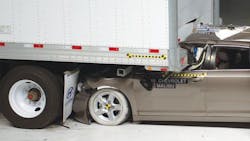NHTSA proposes 'DOT bumper' upgrade
The National Highway Traffic Safety Administration (NHTSA) on Wednesday will publish a notice of proposed rulemaking (NPRM) that focuses on upgrading the federal motor vehicle safety standards that address underride protection in light-vehicle crashes into the rear of trailers and semitrailers.
“Robust trailer rear impact guards can significantly reduce the risk of death or injury to vehicle occupants in the event of a crash into the rear of a trailer or semitrailer,” said NHTSA Administrator Mark Rosekind. “We’re always looking at ways to safeguard the motoring public.”
Most trailers and semitrailers are already required to have bars, known as rear impact guards or “DOT bumpers,” hanging from the back of the trailer to prevent underride. NHTSA proposes to require more robust rear impact guards that will improve underride protection in higher speed crashes compared to current rear impact guards.
The occupant crash protection features built into today’s passenger vehicles are able to provide high levels of occupant protection in 35 mph frontal crashes. This NPRM would require trailer and semitrailer guards to remain in place and prevent PCI in crashes of severities of up to 35 mph versus the current requirement of up to 30 mph.
The Insurance Institute for Highway Safety, which has long called for more robust underride protections, called the proposal “a step in the right direction.”
Russ Rader, IIHS senior vice president for communications, explained to Fleet Owner that NHTSA is aligning U.S. standards with those already in place in Canada and, indeed, most trailers already comply.
“IIHS crash tests show that even guards adhering to the Canadian rules can fail and allow catastrophic underride in crashes that involve the outer edges of the guards,” Rader said. “Some manufacturers are already going beyond the Canadian standard, and tests show those guards do a better job in more kinds of crash scenarios.”
Trailers will have to continue to go through tests conducted by IIHS, and they’ll have to be able to handle offset crashes, he noted.
NHTSA estimates, on average, that the annual incremental material and fuel cost would be $13 million to ensure that all applicable future trailers and semitrailers in the U.S. fleet will be built to the more rigorous standards.
A pre-publication copy of the 108-page NPRM is here. The official Federal Register notice will be available here beginning Dec. 16. Comments can be submitted to the docket up to 60 days after publication.
